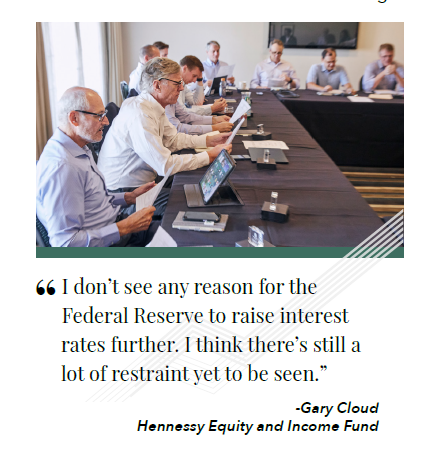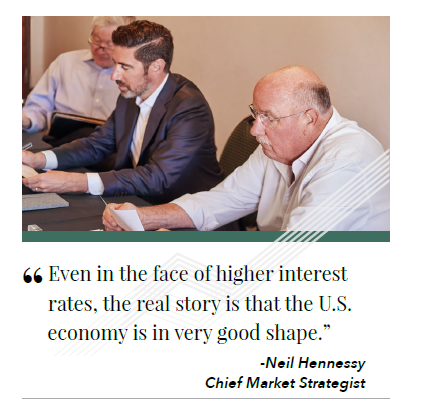2023 CIO Roundtable
For the ninth year, our seasoned portfolio management team gathered to share their insightful market and economic perspectives.
When you put distinguished and active Portfolio Managers in a room together, you are going to get a lively discussion. This year’s CIO Roundtable highlights include insights on the U.S. and Japanese markets, Federal Reserve policy, inflation, interest rate direction, the state of the Energy transition, and the case for active investing. And for the first time since the pandemic, Portfolio Manager Masa Takeda of Tokyo-based SPARX Asset Management joined in person to share his “feet on the street” perspective of Japanese equities.
A Message From Our CIO:
The stock market has once again seen dramatic differences in performance in 2023.
Through November 30, 2023, all three broad based indexes were positive, although with a large dispersion of total returns. The Dow Jones Industrial Average was up 10.72%, the S&P 500® Index rose 20.79%, and the Nasdaq Composite Index increased 37.00%. Large caps significantly outperformed mid and small caps, and growth substantially outperformed value over the same timeframe. Large-cap tech once again pushed the overall broader market higher, as evidenced by the Nasdaq-100 Index posting a return of 46.96%.
Looking ahead, we believe the outlook for U.S. stocks remains positive, primarily as we believe that the Federal Reserve may be done, or close to done, raising interest rates. Inflation has shown signs of easing, creating a better environment for consumers as well as businesses. The unemployment rate remains near record lows, there are elevated levels of cash on the balance sheets of U.S. companies and in the pockets of many consumers and investors, and there is the prospect of a more dovish Federal Reserve heading into 2024. We are cautiously watching certain parts of the economy for any hints of weakness, including consumer spending and credit issues.
While volatility and uncertainty may impact the markets, we encourage investors to stay the course, maintain a diversified portfolio, and keep a long term perspective.
We hope you enjoy the following perspective from our team of talented and seasoned Portfolio Managers.
-Ryan C. Kelley, Chief Investment Officer
Market and Economic Overview
On a year-to-date basis through November 2023, equity performance came from a relatively few number of mega-cap technology companies. The S&P 500® Index rose 20.79% from January through November 2023, however eight technology giants—Microsoft, Tesla, Facebook (Meta), Apple, Amazon, Netflix, Nvidia, and Google, or “MT. FAANNG”—rose 97.27% on average over the same period and comprised approximately 72% of the S&P 500’s 2023 gain.
Small and mid-cap stocks have lagged their large-cap counterparts this year. From January through November 2023, the Russell 2000® Index has risen only 4.14% and the Russell Mid-Cap® Index climbed 8.80%
The Fed’s Actions to Control Inflation.
The 2023 market was driven by investors’ reaction to the Federal Reserve’s tightening monetary policy. High inflation and low unemployment drove the Fed to increase interest rates 11 times from March 2022 through November 2023, bringing its benchmark interest rate from 0.25% to 5.5%, its highest level in 16 years. Since the last increase in July 2023, the Fed has not raised rates at their September and October/November meetings.
As we head into an election year, we believe the Fed will end its rate increases. The fed funds rate appears sufficiently restrictive, and the U.S. economy appears to be experiencing a soft landing given the low unemployment rate. In a recession, companies produce and sell less and therefore presumably need fewer employees. Hence, the U.S. unemployment rate has remained under 4% from January 2022 through October 2023. Additionally, with many corporations flush with cash, the economy appears to be in good shape.
However, what is challenging about this environment is knowing the financial strength of the consumer given the emergency assistance provided by the government to families impacted by the pandemic. Could that money be propping up the economy until those savings run out?
Still, a comparison to prior periods of inflation is encouraging. In the early 1980s, the U.S. experienced double-digit inflation rates because there were multiple cost-of-living increases in employees’ contracts. Currently, wages are rising slowly over multiple years and have not been tied to cost-of-living increases.

Unfortunately, the Fed’s zero interest rate policy led to a few unintended consequences, including highly publicized bank failures. Earlier this year, as rates rose and debt security prices dropped, banks’ capital levels declined, and in a few extreme instances depositors rapidly withdrew funds from certain riskier banks, including Silicon Valley Bank (SVB), Signature Bank and First Republic Bank, leading to solvency issues and failures. Throughout 2023, only a minority of banks were severely impacted by significant withdrawals among the approximately 5,000 banks in the U.S. Fortunately, smaller commercial banks have not seen significant outflows as they typically have strong relationships with their customers.
U.S. Housing
Another unintended consequence of quickly rising rates is the impact on the existing home market. Fewer homeowners are selling their homes because of their low interest rate mortgage. In fact, about 80% of mortgage holders reported having an interest rate of less than 5%. On the other hand, many homebuyers cannot afford the homes that are on the market. As a result, existing home sales have fallen to a level comparable to where they were after the Great Financial Crisis, shifting demand toward new homes. Specifically, newly built single-family homes in the U.S. used to represent only 15% of transactions; now they represent over 30%. In addition, new home prices have not declined materially since there has been so much pent-up demand for housing.
Therefore, young families who have built up savings to buy homes now face 30-year fixed mortgage rates that have approached 8% coupled with higher housing prices. As a result, affordability levels have fallen, and many potential new buyers are instead using their savings to renovate their existing home or on travel.
In its effort to avoid a recession, the government may have caused a longer-term concern. With the U.S. at multi-decade lows in terms of housing affordability, we see the relationship reconciling by either lower housing prices or higher wages, both of which could be headwinds for the economy.
Is the Best Decade in Japan Yet to Come?
At the Hennessy Funds, we are cautiously optimistic about the Japanese economy. The country has been making slow and steady progress over the past several years following the implementation of Abenomics and the introduction of the corporate governance and stewardship codes. We believe multiple key drivers in Japan will lead to the recovery of the domestic economy.

Sustained Inflation
In contrast to the U.S., Japan welcomes inflation to emerge from its long-standing deflationary environment. During Japan’s spring wage negotiation between labor unions and large companies, salaries increased an average of 3.6% on a year-over-year basis—the largest increase since 1993. However, with the inflation rate trending above 3%, real wage growth has remained in negative territory. To encourage future wage increases, the government has been incentivizing businesses to continue raising salaries.
In addition, some inflationary signals are structural:
1. Japan’s population of 120 million people started to decline around 2008-2009 but the total labor market has remained steady due to the rehiring of older citizens and increasing participation by women. Once this trend is exhausted, a shortage of labor should contribute to an increase in inflation.
2. In many cases, companies must build separate supply chain systems for China, the U.S., and Europe, adding to the cost of doing business.
3. The Tokyo Stock Exchange has urged publicly traded companies trading below 1x book value to implement changes to encourage higher returns. Given that approximately 50% of public companies are trading at less than 1x book value, there is substantial room for these companies to improve their share prices through better capital efficiency and improved profitability.
Inbound Tourism Rebounds
At the peak in 2019, 30 million tourists visited Japan, spending an average of $1,200 per person, or approximately 1% of Japan’s annual GDP. In 2023, the pace of inbound tourists accelerated. From January through September, over 17 million tourists visited Japan and in October, the number of foreign visitors exceeded pre-pandemic levels, marking a full recovery in arrivals. We believe the amount spent per tourist should be higher because the Japanese yen is weaker relative to 2019 levels. With the same amount of dollars, tourists’ purchasing power increased by 30%.
Warren Buffett’s Bets Big on Japan
We believe Warren Buffet’s increased investment in Japan was a vote of a confidence for Japanese stocks. Earlier this year, Berkshire Hathaway added to its stake in five Japanese trading firms—Mitsubishi Corp., Mitsui & Co., Sumitomo Corp., ItochuCorp., and Marubeni. Buffett stated he felt better deploying capital in Japan than in Taiwan for geopolitical reasons.
Berkshire isn’t the only firm making significant investments in Japan. As examples, the world’s biggest chipmaker, Taiwan Semiconductor Manufacturing Co., plans to build a second semiconductor manufacturing plant in Japan at a cost exceeding $7 billion, and Micron Technology is expanding capacity and investing around $3.6 billion in advanced memory-chip making in Hiroshima, Japan.
Long Runway for Japan Equities
Although Japan has been making slow yet steady progress over the past several years, Japanese equities remain undervalued in our opinion. In terms of valuations, if the Japanese economy remains resilient, earnings growth should help increase share prices and valuations should also expand. Since 2013 when Abenomics started, corporate earnings per share (EPS) has roughly tripled along with the Tokyo Stock Index (TOPIX), which also tripled in value. Therefore, earnings and stock market prices have risen in lockstep but there has not been a significant increase in price/earnings. With companies focused on returns on capital along with sustained inflation, we believe there’s a long runway for Japan equities.
The World’s Diverse Energy Needs
Elevated interest rates and higher inflation levels have created a headwind for many renewable energy projects, providing an opportunity to thoroughly reevaluate these projects from an economic threshold standpoint. Many companies with renewable energy projects face higher funding, raw materials, and labor costs, forcing the cancellation of some plans. By contrast, many investors remain optimistic around the electrification of transportation. One example is Exxon’s plan to develop lithium reserves in Arkansas and become a leading supplier for electric vehicles by 2030.

While we expect renewable energy to continue to grow, many investors have begun to realize that it will be a decades-long process. In the meantime, we believe renewables and natural gas complement each other. Natural gas is efficient, reliable, affordable, and abundant, while renewables offer environmental advantages and are becoming more cost competitive.
Oil and Natural Gas Demand
The direction of oil and natural gas prices is mostly reliant on the strength of the economy, the macro outlook, and interest rates. There has been this perception that monetary tightening would have a headwind effect on the global economy, which generally translates to weaker energy demand. Yet the economic strength of the U.S. continues to defy expectations as shown in the revised estimates for GDP growth over the past year. At the beginning of 2023, the forecast for real GDP in the U.S. was around 0.6% but over the course of the year, the expectation rose to over 2%. For 2024, in August, the Bloomberg consensus economic forecast for real GDP growth was approximately 0.7%. More recently, that forecast was revised higher to about 1%. For 2024, while we may see pockets of weakness, we expect growth in demand for crude oil and natural gas.
The Case for Active Investing
As noted at the beginning of the CIO Roundtable, the MT. FAANNG stocks rose, on average, nearly 90% in 2023 on a total return basis as of November 30, 2023. However, this same group was down -46.71% in 2022, a dismal year for large-cap technology stocks. Due to the unforgiving nature of percentages, from the end of 2021 until the end of November, this group of highflyers was up less than 1%, on average, despite incredible gains in 2023.
We believe this example underscores the importance of a long-term investment perspective, embodied in many of Hennessy Funds’ investment philosophy elements:
• It’s not about timing the market, it’s about time in the market. If an investor poorly times when to enter and exit the market, it would be difficult to achieve attractive returns compared to what they would experience simply by staying invested.
• We are optimistic investors. We understand that some years or months may be tougher than others, but we tend to think in longer timeframes.
• Downside risk mitigation is relevant. While we normally remain fully invested, we seek to reduce risk through other means, including sector diversification and investing in companies that exhibit strong fundamentals at compelling valuations.
• We are investors in companies, not traders of stocks. Many of our portfolios hold certain positions for long periods of time,
a demonstration of the Portfolio Managers’ convictions.
• We are long term investors, staying ever mindful of downside risk while striving to participate in the upside, with each individual fund having its own objective, process, portfolio construction, and investment criteria.

- In this article:
- Overall Market
- Cornerstone Mid Cap 30 Fund
- Energy Transition Fund
- Focus Fund
- Cornerstone Growth Fund
- Cornerstone Large Growth Fund
- Cornerstone Value Fund
- Total Return Fund
- Equity and Income Fund
- Balanced Fund
- Gas Utility Fund
- Small Cap Financial Fund
- Large Cap Financial Fund
- Technology Fund
- Japan Fund
- Japan Small Cap Fund
- Midstream Fund
You might also like
-
 Market Outlook
Market OutlookHennessy Funds 2025 CIO Roundtable
 Neil J. HennessyChief Market Strategist and Portfolio Manager
Neil J. HennessyChief Market Strategist and Portfolio Manager Ryan C. Kelley, CFAChief Investment Officer and Portfolio Manager
Ryan C. Kelley, CFAChief Investment Officer and Portfolio Manager Ben Cook, CFAPortfolio Manager
Ben Cook, CFAPortfolio Manager Masakazu Takeda, CFA, CMAPortfolio ManagerRead the Commentary
Masakazu Takeda, CFA, CMAPortfolio ManagerRead the CommentaryHennessy Funds’ Portfolio Managers recently gathered for our annual CIO Roundtable. For the 11th year in a row, they discussed the latest market trends, shared insights, and explored strategies for navigating the ever-changing investment landscape.
-
 Market Outlook
Market OutlookBeyond the Headlines: Investment Opportunities in Uncertain Times
 Ryan C. Kelley, CFAChief Investment Officer and Portfolio ManagerRead the Commentary
Ryan C. Kelley, CFAChief Investment Officer and Portfolio ManagerRead the CommentaryRyan Kelley, Chief Investment Officer, discusses 2025 market volatility, strength in sectors like Utilities, Energy, and Financials, and the appeal of mid-cap stocks. He emphasizes staying diversified and focused on the long term amid ongoing uncertainty.
-
 Market Outlook
Market OutlookNavigating Uncertainty: A Perspective on Market Volatility
Read the CommentaryThe Portfolio Management team at Hennessy Funds stand by their philosophy of maintaining a time-tested investment approach to their high-conviction portfolios.
